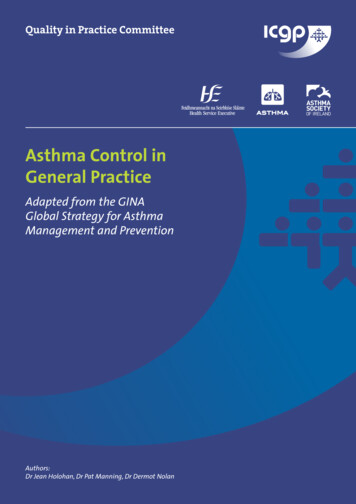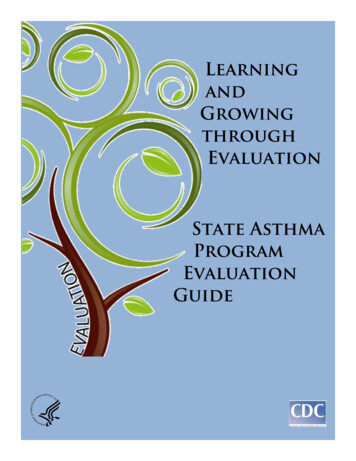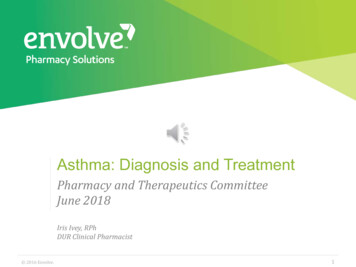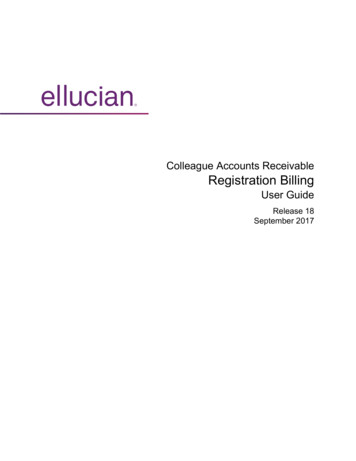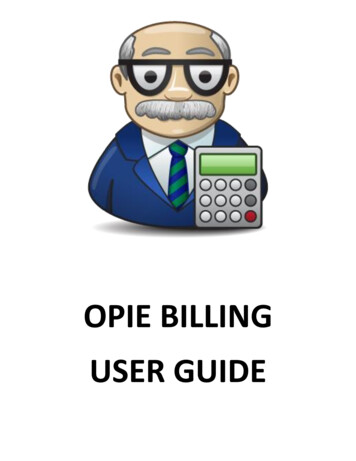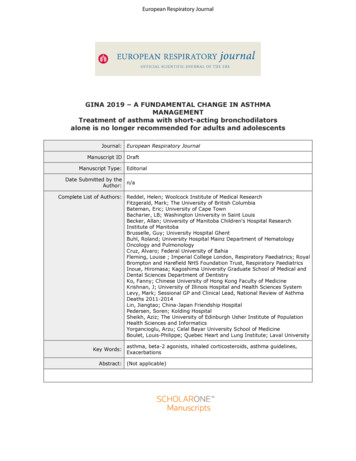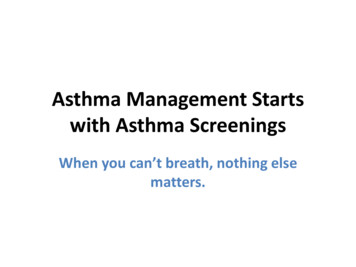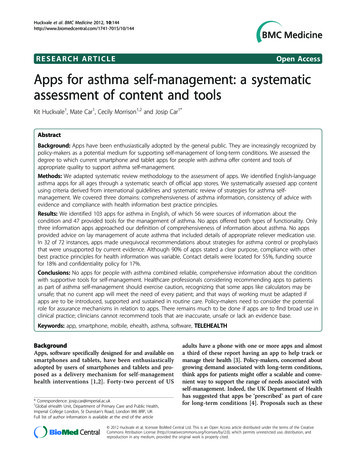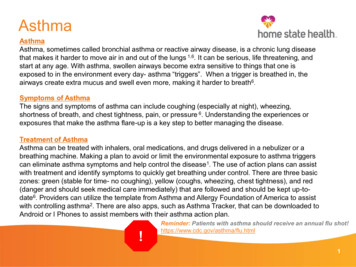
Transcription
AsthmaAsthmaAsthma, sometimes called bronchial asthma or reactive airway disease, is a chronic lung diseasethat makes it harder to move air in and out of the lungs 1,6. It can be serious, life threatening, andstart at any age. With asthma, swollen airways become extra sensitive to things that one isexposed to in the environment every day- asthma “triggers”. When a trigger is breathed in, theairways create extra mucus and swell even more, making it harder to breath6.Symptoms of AsthmaThe signs and symptoms of asthma can include coughing (especially at night), wheezing,shortness of breath, and chest tightness, pain, or pressure 6. Understanding the experiences orexposures that make the asthma flare-up is a key step to better managing the disease.Treatment of AsthmaAsthma can be treated with inhalers, oral medications, and drugs delivered in a nebulizer or abreathing machine. Making a plan to avoid or limit the environmental exposure to asthma triggerscan eliminate asthma symptoms and help control the disease1. The use of action plans can assistwith treatment and identify symptoms to quickly get breathing under control. There are three basiczones: green (stable for time- no coughing), yellow (coughs, wheezing, chest tightness), and red(danger and should seek medical care immediately) that are followed and should be kept up-todate6. Providers can utilize the template from Asthma and Allergy Foundation of America to assistwith controlling asthma2. There are also apps, such as Asthma Tracker, that can be downloaded toAndroid or I Phones to assist members with their asthma action plan.!Reminder: Patients with asthma should receive an annual flu shot!https://www.cdc.gov/asthma/flu.html1
AsthmaGoalTo provide coding and risk adjustment education including documentation on specificity of the disease andenhance the awareness of related HEDIS measures. Encourage open discussions between coder/provider.AudienceBillers, Coders, Providers, including but not limited to Nurse Practitioners, Physician Assistants, GeneralPractitioners, Family Medicine, Internal Medicine, and Pediatricians.WAVES ProgramThe asthma WAVES program is specific to Home State Health. It is a case management initiative programthat provides telephonic outreach, education and support services to promote adherence to asthmatreatment, prevent exacerbations and optimize functional status for members who have asthma.Refer a member Phone: 1-855-694-4663 ext 607512Email: HSHPCaseManagement@CENTENE.COMFax form: ral-Form-REVISED10.02.pdfResources1. American Lung ma/ )2. Asthma and Allergy Foundation of America Asthma Action Plan pdf)3. Home State Health website sources/coding-page.html4. 2019 ICD-10-CM Expert for Physicians: The Complete Official Code Set, Optum360. 2018 Optum360 LLC5. HEDIS 2019 Technical Specification for Health Plans6. WebMD: Asthma Health Center (http://www.webmd.com/asthma/default.htm)2
Asthma Coding GuidanceTIPS: ICD-10-CM CodesICD-10 Mapping & EducationBe sure to check for 6th digit of:0 uncomplicated1 acute exacerbation2 status asthmaticusJ45.2-Mild Intermittent AsthmaJ45.3-Mild Persistent AsthmaJ45.4-Moderate Persistent AsthmaJ45.5-Severe Persistent AsthmaJ45.901Unspecified asthma with acute exacerbationJ45.990Exercise induced bronchospasmJ45.902Unspecified asthma with status asthmaticusJ45.991Cough variant asthmaJ45.909Unspecified asthma, uncomplicatedJ45.998Other asthma Attempt for morespecificity Avoid broad terms and unspecified codes such as “Unspecified Asthma”, J45.909Documentation should include the following: Frequency: Intermittent PersistentSeverity: Mild Moderate Severe Environmental Factors: Allergies Exposure to smoke Use additional code To identify any of the following:Exposure to second hand tobacco smoke (Z77.22)History of tobacco dependence (Z87.891)Tobacco use (Z72.-) Asthma Action Plan Medications and longterm use steroids/drugtherapy codes HEDIS 2019Tobacco dependence (F17-)Exposure to tobacco smoke in perinatal period (P96.81)Occupational exposure to environmental tobaccosmoke(Z57.31)Asthma Action Plan is a communication tool that everyone with asthma should utilize. It providesinformation and instructions for the member. Visit Verify asthma is documented in the note and addressed in the Assessment & Plan with any medicationchanges. Below is a list of common asthma medications, but not limited to: Advair Albuterol Flovent Singulair Pulmicort SymbicortAdditional codes to identify medication use:Long term (current) use of inhaled steroids (Z79.51)Long term (current) use of systemic steroids (Z79.52)Other long term (current) drug therapy (Z79.899)Medication Management for People with Asthma (MMA)Members 5-64 years of age identified as having persistent asthma and dispensed appropriate medicationsthat they remained on during the treatment period. 2 rates are reported: Percentage of members whoremained on an asthma controller medication for at least 50% and then 75% of their treatment period.Asthma Medication Raito (AMR)The percentage of members 5-64 years of age who were identified as having persistent asthma and had aratio of controller medications to total asthma medications of 0.50 or greater during the measurement year.3
Asthma Action PlanEach member with a diagnosis of asthma should have an asthma action plan in writing. An asthmaaction plan is considered a documentation tool that assists with continuity of care for the member,including schools, nurses, teachers, and other care givers. Note all disclaimers on the n-planGreen meansGo ZoneYellow meansCaution ZoneRed meansDanger Zone9/5/20194
Billing Sample #1Primary Care Physician Documentation: Medical record SOAP format (condensed)DOS: 11/24/2018Gender: M DOB: XX/XX/2013 Pulse: 122 Temp:97.5 FWeight: 61lb Height: 3.9 BMI: 21.2, 99th percentileHPI: A 5 y.o. male with a history of asthma brought in for cough and sorethroat. Sore throat started yesterday and gradually worsening.Problem List/History: Asthma: on Advair, no wheezing today. Otitis Media:resolved 8/2018.ROS: Positive for cough, congestion, drooling, rhinorrhea and sore throatGI: Negative for N/V, abdominal pain, constipation; GU: Negative for difficultyurinating; Skin: Negative for color change; Neurological: Negative for facialasymmetry and speech difficulty; Psych: Negative for behavioral problemsPMH: Up-to-date with immunizationsPSH: Dad smokes in the car/outside of the houseExam: Vitals reviewed.Constitutional: Appears well-developed and well-nourished. Active.HEENT: Normocephalic, Ears clear; Greenish nasal discharge and congestionpresent.Mouth/throat: Mucous membranes are moist, pharynx erythema present,tonsils are 1 bilaterallyCardiovascular: Normal rate and regular rhythmPulmonary Chest: Effort normal and breath sounds normalAbdominal: Soft, bowel sounds present.Skin: Warm and dry.Assessment and Plan:Sore throat–Ordered POCT rapid strep AAcute URI–rapid strep negative, adequate hydration, warm salt water gargles,saline nasal spray, Tylenol for pain/feverMild Persistent Asthma without complications– Continue current treatmentfor asthma, Asthma Action Plan reviewed, continue Advair daily use, ifwheezing occurs or congestion continues, should call the office. Encourage dadto quit smoking.Claim Diagnosis Codes & RationaleICD-10CMDescriptionMedical Record SupportJ02.9Sore throat HPI, Assessment & Plan: Provider noted sore throatstarted yesterday and gradually worsening;completed a rapid strep A test.J06.9Acute, URI Exam, Assessment & Plan: Provider noted greenishnasal discharge and congestion present, listed AcuteURI- noted rapid strep negative, adequate hydration,warm salt gargles, saline nasal spray, Tylenol for painand fever.J45.30Mild PersistentAsthmawithoutcomplications HPI, Assessment & Plan: Provider documentedhistory of asthma, currently on Advair; documentedMild Persistent Asthma without complications tocontinue current treatment, Action plan reviewed.Z77.22Contact withand exposuretoenvironmentaltobacco smoke PSH, Assessment & Plan: Provider listed dad smokesin the car/ outside of the house; encouraged dad toquit.Z79.51Long term useof inhaledsteroids Problem List: Provider stated patient using Advair,no wheezing.Rationale: Codes from Z79- category indicate apatient’s continuous use of prescribed drug for longterm use of inhaled steroids.Body MassIndex (BMIpercentile), 99th Z68.54 HPI: Patient BMI percentile 99thRationale: Codes from Z68- category indicates apatient’s BMI was documented in the record and thiscan assist with HEDIS BMI measure.5
Billing Sample #2Specialist Documentation: Medical record SOAP format (condensed)DOS: 11/12/2018Gender: F DOB: XX/XX/2006 Pulse: 100 Temp: 98.6 FWeight: 177 lb Height: 5.3.6 BMI: 30.78HPI: A 12 y.o. female came in for follow up for her asthma. Currentmedication, Singulair, is working overall, but is experiencing a coughduring nighttime.ROS: Negative for fever and chills. No ear pain, no eye painNegative for shortness of breath and wheezing. Negative for chest painand palpitations. No nausea or vomiting. Negative for dysuria andfrequency. Positive for environmental allergies- seasonal allergies.No rashes. No dizziness or headaches. No behavioral issues.PFS History:No known allergies, immunizations are up-to-dateNonsmokerMom and sister has asthmaMedication List:Albuterol-inhale 2.5 mg every 4 hours, as neededCetirizine- take 10 mg by mouth dailySingulair- take 1 tablet by mouth nightlyExam:Constitutional: She appears well-developed. She is obese due toexcess calorie intake. HEENT: normal.Pulmonary/Chest: Effort normal and breath sounds normal.Abdominal: Soft, bowel sounds are normal, no tenderness.Assessment/Plan:Body Mass Index- 30.78 95th percentile for age. Will ask PCP tomonitor.Mild, intermittent asthma- continue current medications andencouraged her to use albuterol as needed but not to exceed 4 times aday. Reviewed her asthma action plan and asthma triggers.Seasonal allergies- Continue to take Cetirizine daily and monitor asthmatriggers.Claim Diagnosis Codes & RationaleICD-10-CMDescriptionMedical Record SupportJ45.20Mild intermittentasthma,uncomplicated J30.2Other seasonalallergic rhinitis E66.09Other obesity dueto excess calories HPI: Provider documents patient came in for followup for asthma. Provider noted the medication isworking but is experiencing nighttime coughing.Rationale: Provided documented mild, intermittentasthma with continue use of medications. She is touse albuterol as needed.ROS & Medication List: Provider documents patientis positive for environmental allergies- seasonalallergies, reviewed the medication list- Cetirizine.Assessment & Plan: Provider noted for patient tocontinue Cetirizine daily and monitor asthma triggers.Exam: Provider documented patient is obese due toexcess calories.Rationale: Provider documented the reason for theobesity; therefore can code as such.Z68.54Body mass index(BMI percentile) 95 percentile forage Exam: Patient BMI documented as 30.78Rationale: Codes from Z68- category indicates apatient’s BMI was documented in the record and thiscan assist with HEDIS BMI measure.Z79.899Other long term(current) drugtherapy Assessment & Plan: Patient has been taking Singulair.Rationale: Codes from Z79- category indicate apatient’s continuous use of prescribed drug for thelong-term treatment of a condition.Z82.5Family history ofasthma PFS History : Provider documents her mother andsister has asthma.Rationale: ICD 10 guidelines state to code familyhistory who has a particular disease that causes thepatient to be at a higher risk of the disease. 6
Billing Sample #3Acute Asthma Exacerbation Note: Medical record SOAP format (condensed)DOS: 10/3/2018Gender: M DOB: XX/XX/2012 Pulse: 93 Temp: 98.6 FWeight: 42lb Height: 45 in BMI: 14.6 (24th percentile) SpO2: 95%HPI:The patient is a 6-year-old male presents with history of asthma andapproximately 12 hours of wheezing and congested cough. He has beenhoarse and some shortness of breath. Father does smoke in the house.He misplaced his albuterol as the family has been packing up the housegetting ready to relocate.Exam:Appetite is normal. No fever. Exam: Active, no distress. Mouth/Throat:Mucous membranes are moist, Oropharynx is clear, Pharynx is normal.Eyes: Equal, round, and reactive to light. Conjunctivae and EOM arenormal, no discharge. Pulmonary/Chest: Effort normal, normal air entry,no stridor, no respiratory distress. Air movement is not decreased. Hehas wheezes (scattered inspiratory and expiratory). No rhonchi, rales noretraction. Abdominal: soft, bowel sounds normal. Genitourinary:normal. Neurological: alert. Skin is warm and dry, no rashes.Assessment/Plan:The patient’s breath sounds improved with an albuterol nebulizedtreatment. Patient was also given Prelone 3mg/mL oral solution. AsthmaAction plan was initiated, reviewed with patient and mother. They wereinstructed to give a copy to the school nurse. The patient should stayhome from school and rest today. No physical activities for theremainder of the day.Diagnosis:Mild intermittent asthma with acute exacerbation. Take Oraped bymouth 10mL daily for 5 days. Continue to use albuterol- inhale 2 puffsevery 4 hours as needed for wheezing and shortness of breath.Second hand smoke exposure- Encouraged dad to quit smoking and tonot smoke in the house or car.Claim Diagnosis Codes & RationaleICD-10CMDescriptionMedical Record SupportJ45.21Mildintermittentasthma withacuteexacerbation HPI, Assessment & Plan: Provider documentedthat the patient had history of asthma andassessed the patient with having mildintermittent asthma with acute exacerbation.Z68.52Body massindex (BMI), 5thpercentile toless than 85th,children HPI: The BMI percentile documented as 24thpercentile.Rationale: Codes from Z68- category indicates apatient’s BMI was documented in the record andthis can assist with HEDIS BMI measure.Contact withand exposure toenvironmentaltobacco smoke Long term(current) use ofsystemicsteroids Other long term(current) drugtherapy Z77.22Z79.52Z79.899 HPI: The patient is exposed to second handsmoke as father smokes in the home.Rationale: ICD 10 CM coding guidelines state toassign status code Z77.22 when a patient hasexposure to second hand smoke.Diagnosis: Patient was instructed to take Orapedby mouth 10mL daily for 5 daysRationale: Codes from Z79.5- category indicatespatient’s long term (current) use of steroidsAssessment & Plan: Patient has been onalbuterol.Rationale: Codes from Z79- category indicate apatient’s continuous use of prescribed drug forthe long-term treatment of a condition.7
MORE CODING TIPS:One way to document & code chronic conditions is by utilizing the acronymMonitor symptomsdisease progression/regressionordering of testsreferencing labs/other testsEvaluate test resultsmedication effectivenessresponse to treatmentphysical exam findingsAssess/Address discussion, review recordscounselingacknowledgingdocumenting status/level of conditionTreat prescribing/continuation of medicationssurgical/other therapeutic interventionsreferral to specialist for treatment/consultationplan for management of conditionMEAT:General Notes: Chronic Conditionscan be coded duringany type of visit evenif they are stable. Verify the condition,any medications,DME, injections,infusions. Documentation mustsupport that thecondition was eithermonitored, evaluated,assessed, or treatedin order to supportcode assignment8
What are the ICD-10-CM Guidelines?Benefits of Risk AdjustmentThe ICD-10-CM Official Guidelines for Coding and Reporting are rules thatsupplement the conventions and instructions within the ICD-10-CM classification.Adherence to these guidelines is required under the Health Insurance Portabilityand Accountability Act (HIPAA).9
Physician’s RoleRisk adjustment is an important process that allows the State and Federal government to gauge theacuity of a member populations and consequently allocate resources to the members health planaccordingly. This process ensures that members with the highest risk of incurring medical expenseshave the resources available to facilitate high quality care and meet their healthcare needs.Physician data (coding information submitted on physician claims) is critical for accurate risk adjustment.Physician claims data is the largest source of medical data for the risk adjustment models which help to determine howresources are allotted for care of the population. Specificity of diagnosis coding is substantiated by the medical record. Accurate coding helps to best reflect the cost ofcaring for members/patients: It demonstrates the level of complexity for the patient encounters. It is vital to a healthy revenue cycle, and more important, to a healthy patient. Each progress note must: Support what is coded and billed (ICD-10-CM, CPT, and HCPCS). “Stand alone” ensuring all information necessary to support medical necessity for services rendered on agiven date of service are documented within each progress note for that date of service alone. Providers maynot use documentation from a previous progress note to support medical necessity for services rendered ona subsequent date of service. Ensure all work for which the provider is given credit towards their medical decision making is clearlydocumented within the progress note. This includes referrals, lab and imaging orders, independent review ofcompleted imaging or lab results and any mental work completed by the provider in determining a definitivediagnosis. Be complete and contain legible signature, credentials, and date. “Document for others as you would want them to document for you.”10
zones: green (stable for time- no coughing), yellow (coughs, wheezing, chest tightness), and red (danger and should seek medical care immediately) that are followed and should be kept up-to-date. 6. Providers can utilize the template from Asthma and Allergy Foundation of America to assist with controlling asthma. 2
